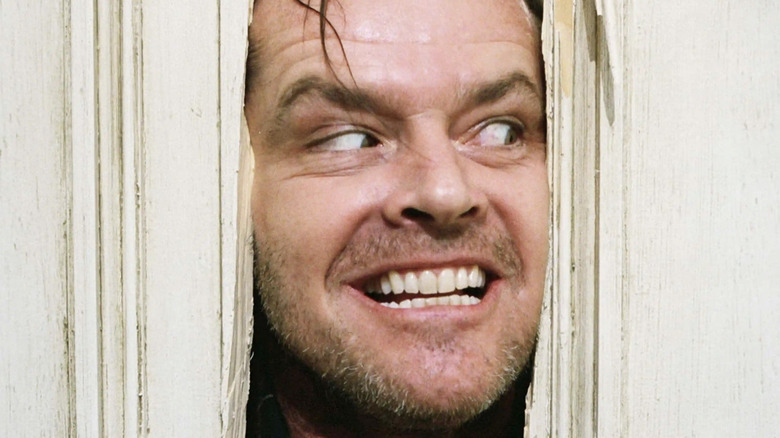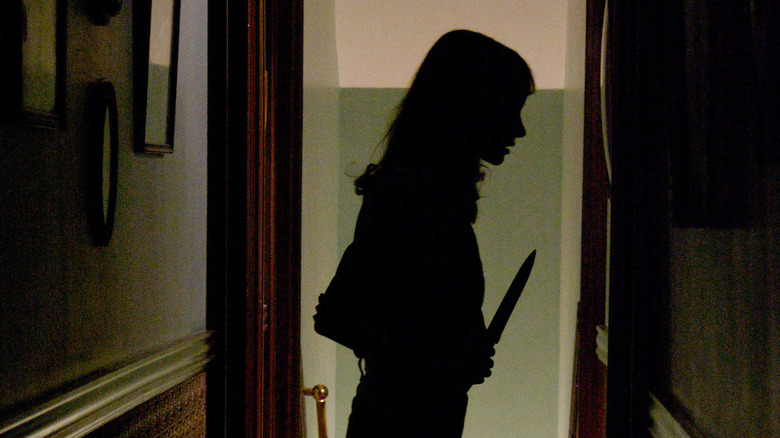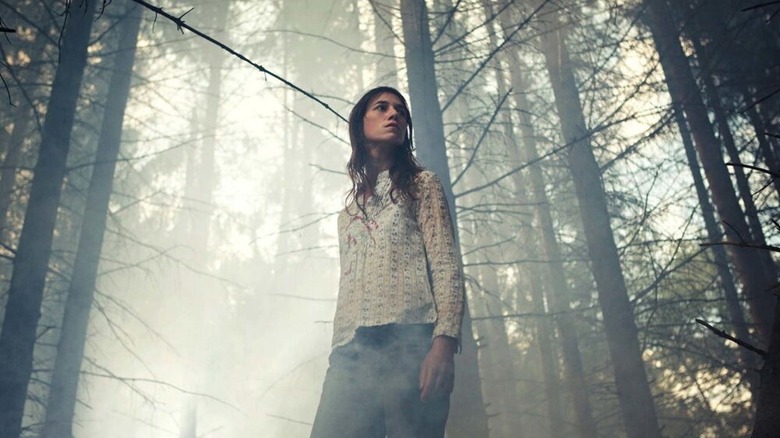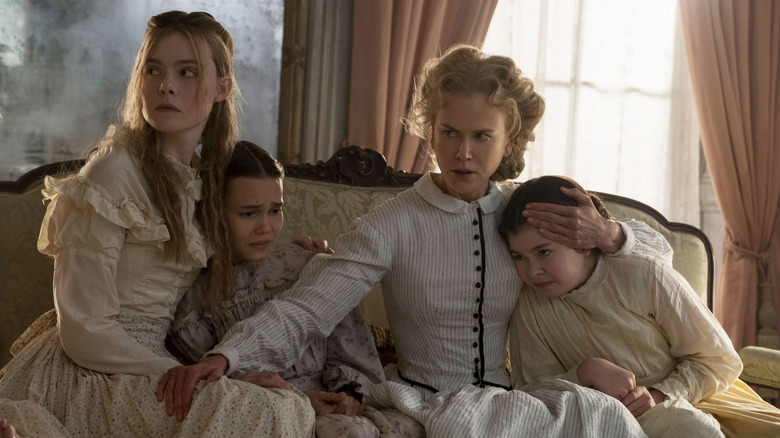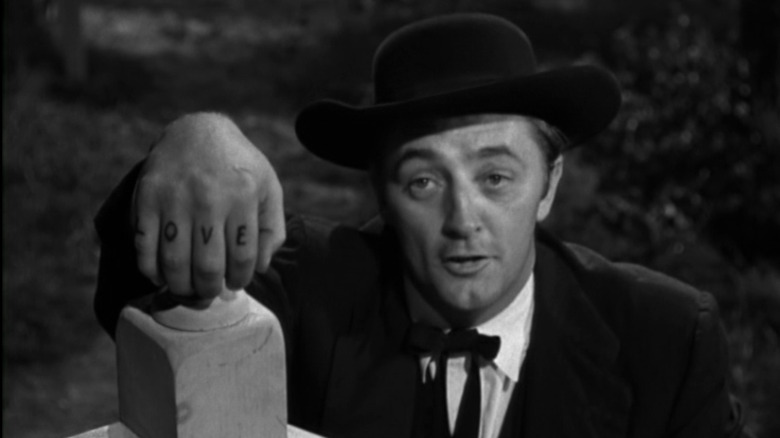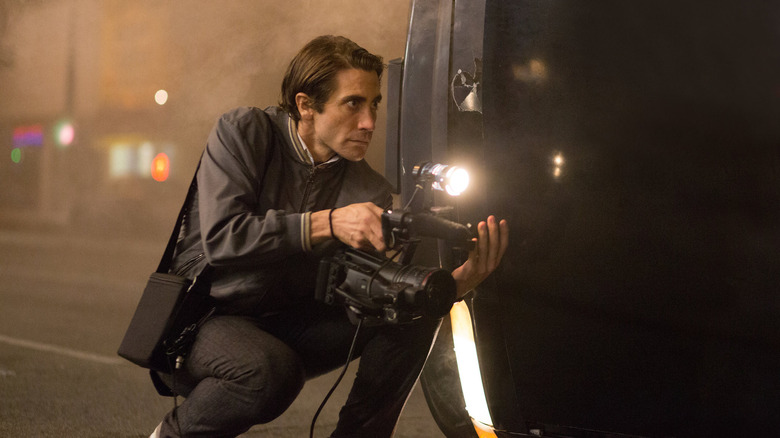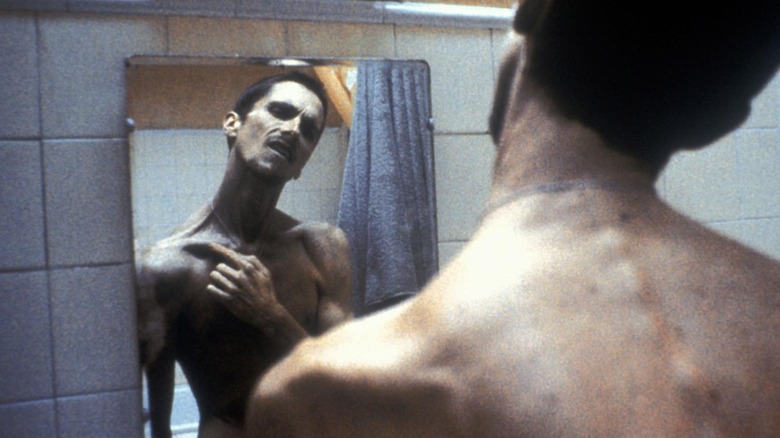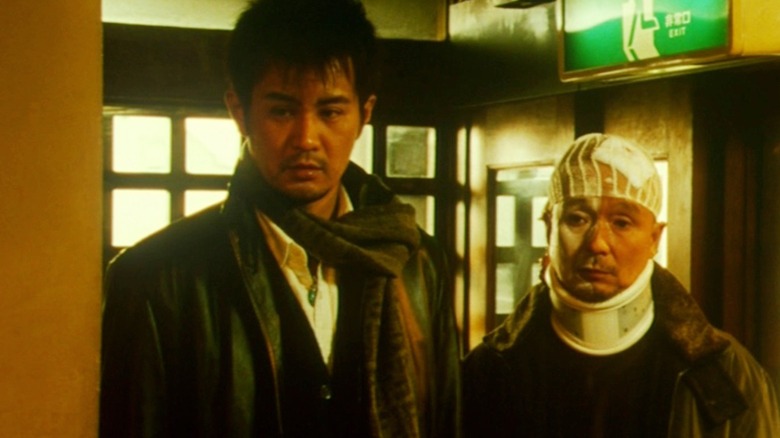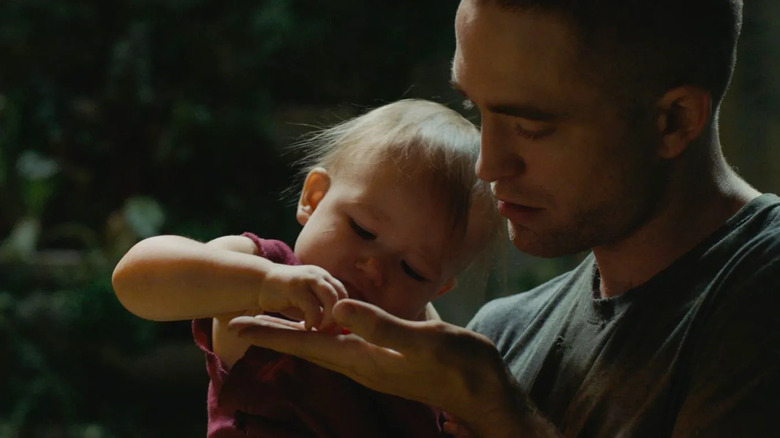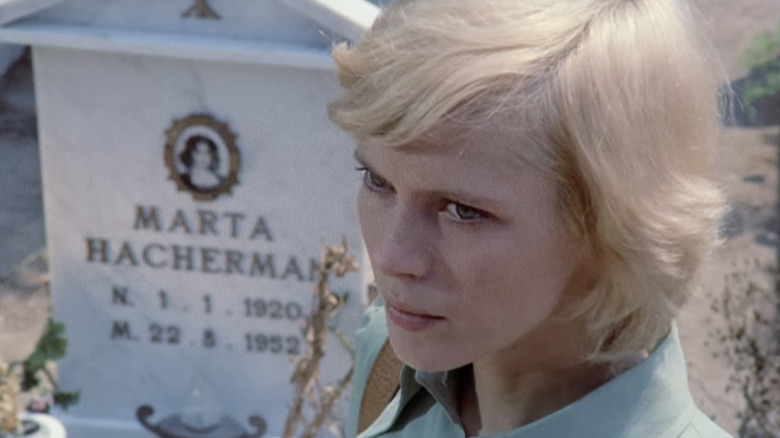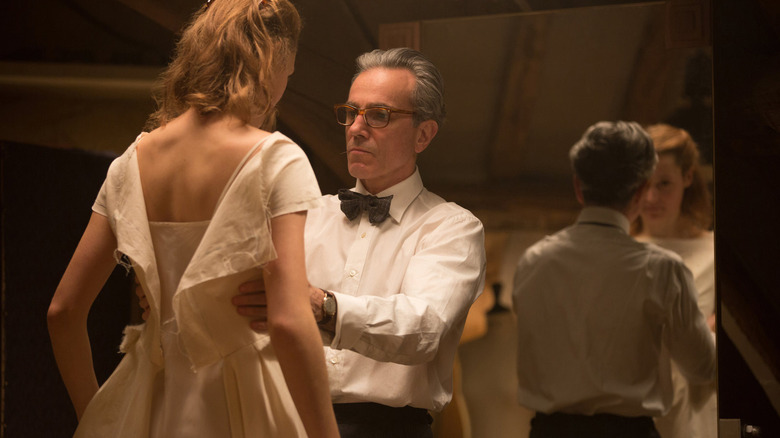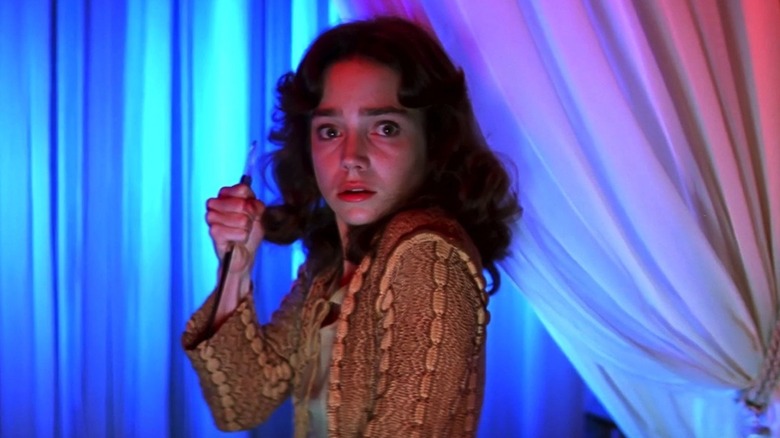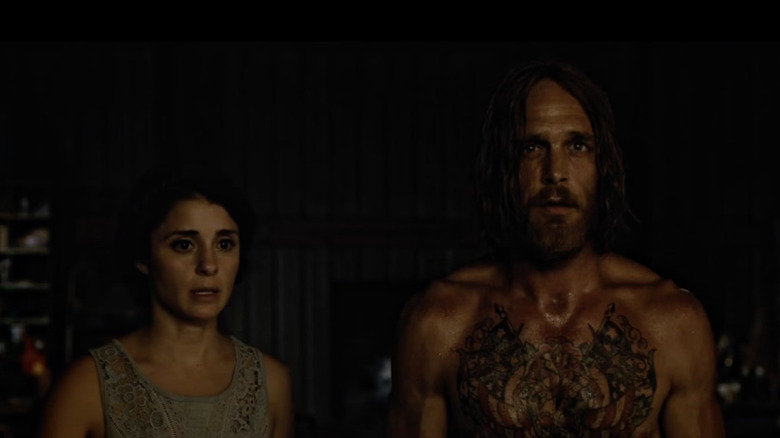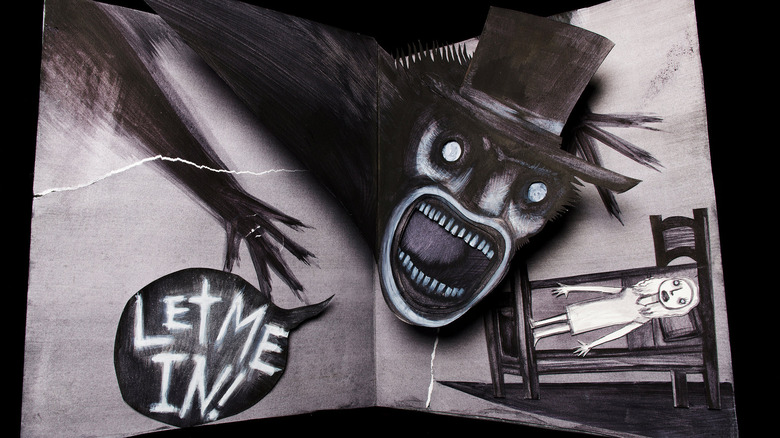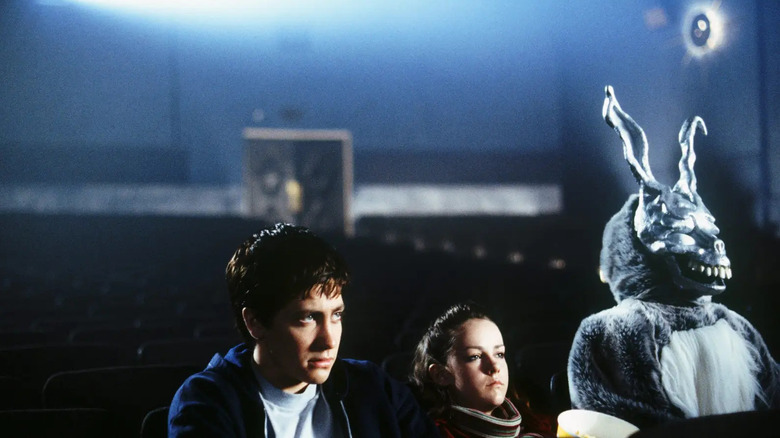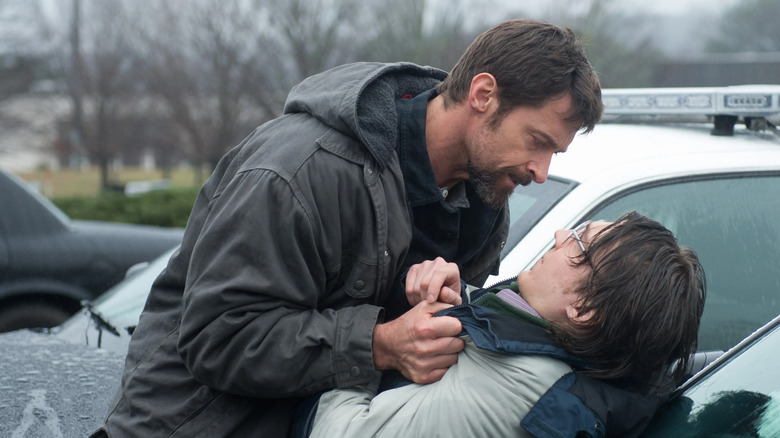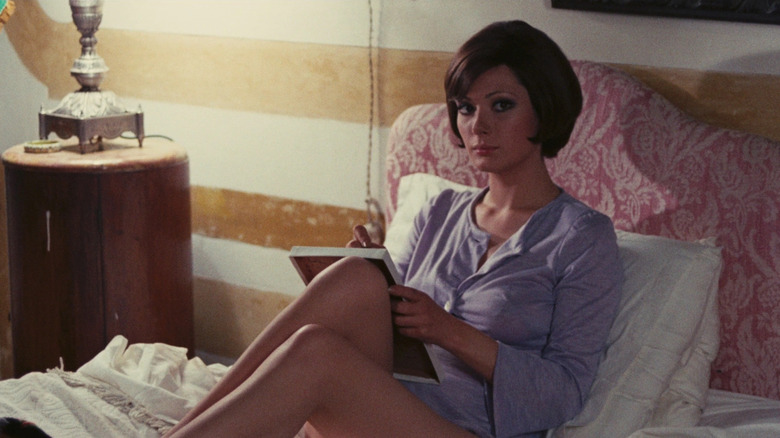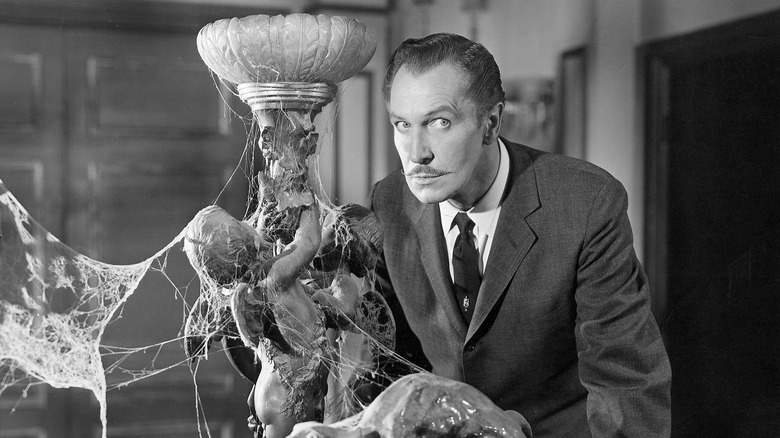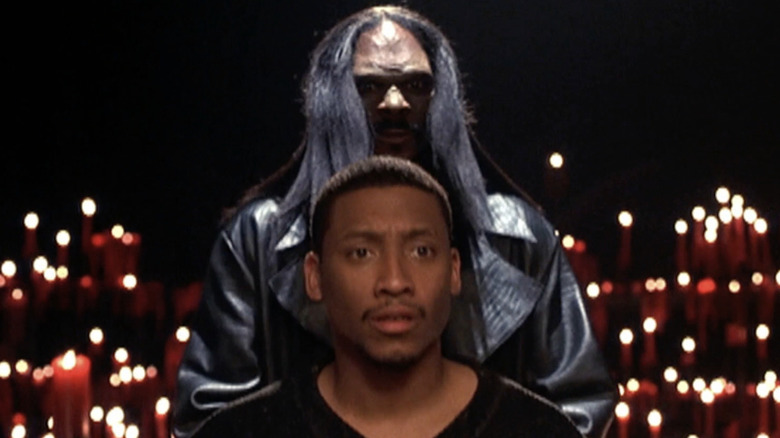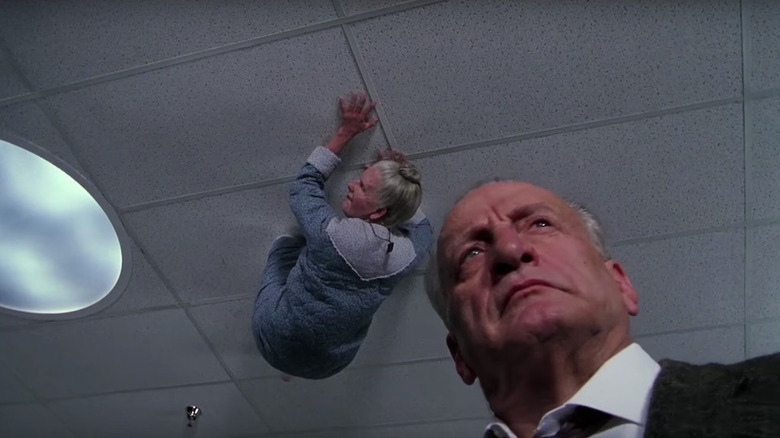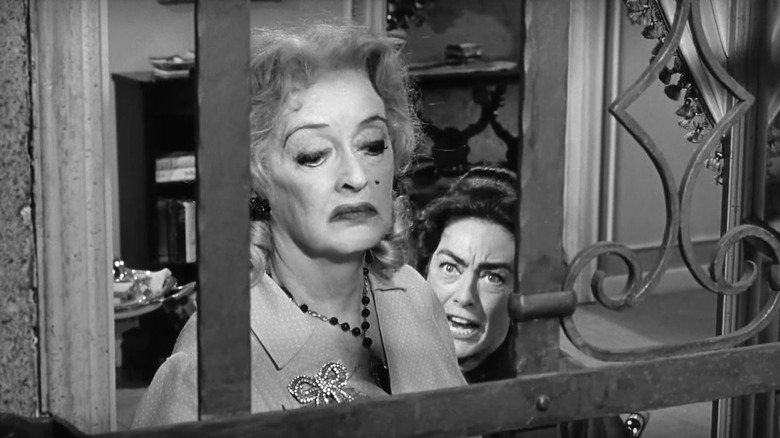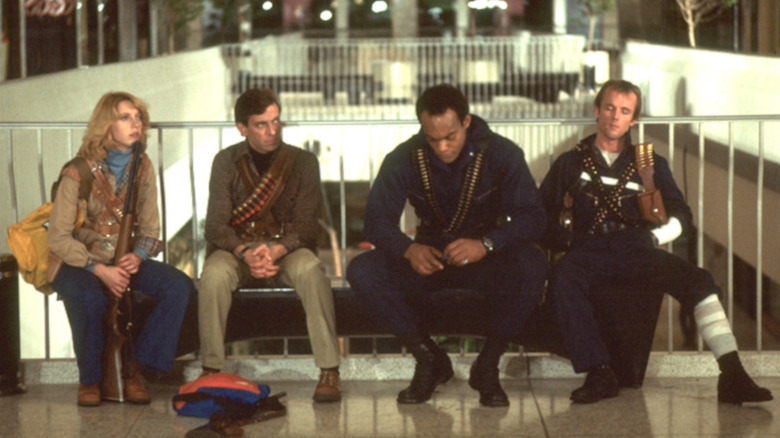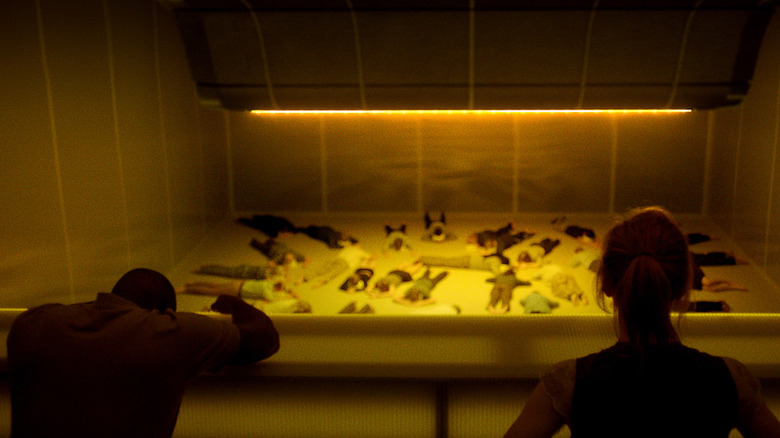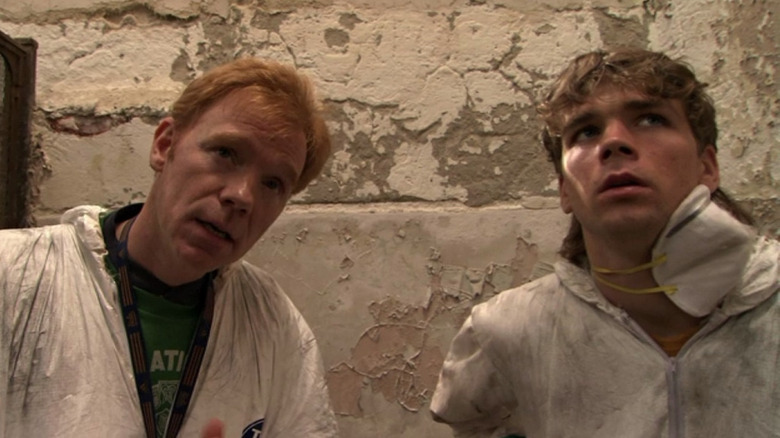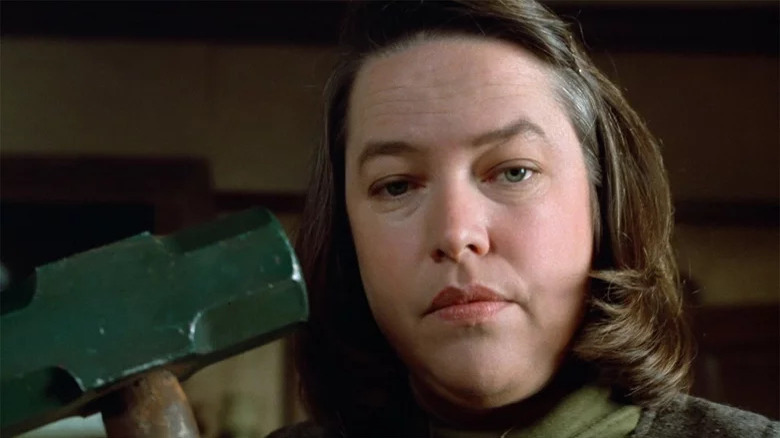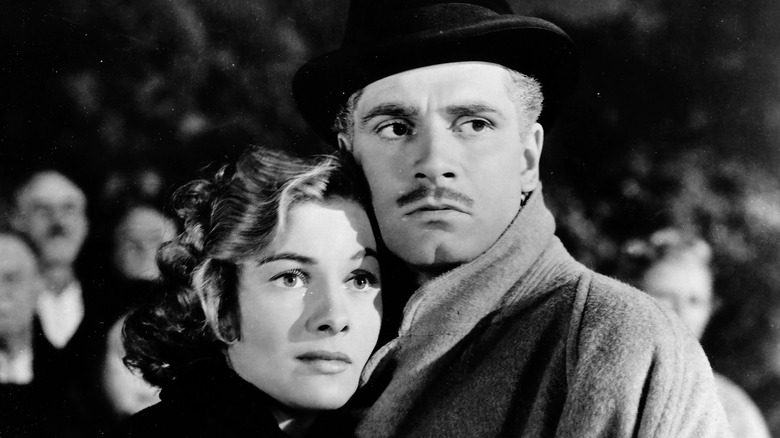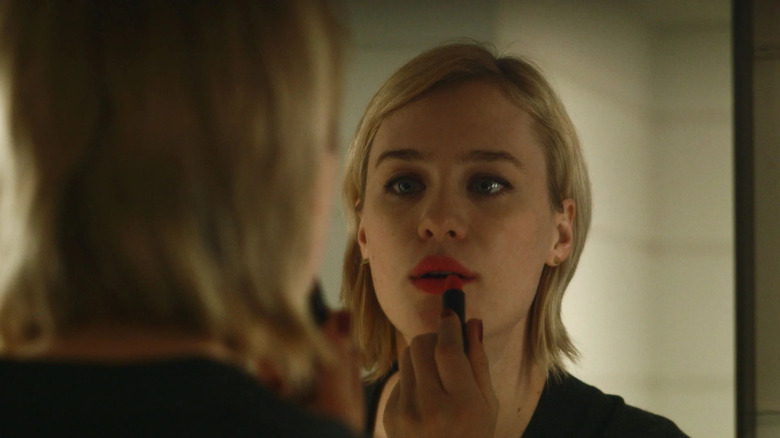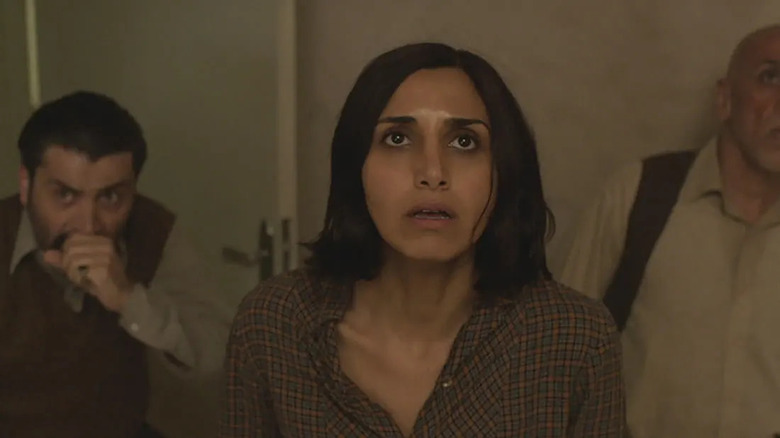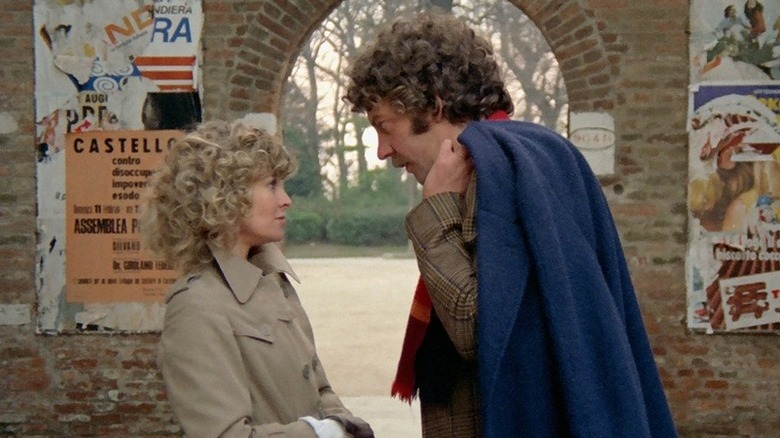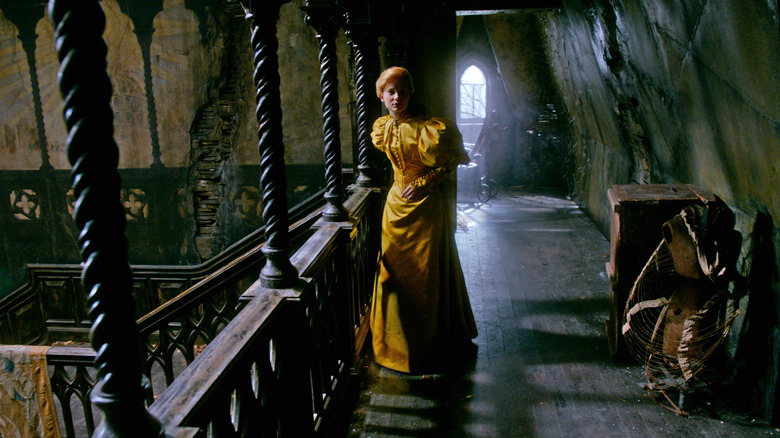30 Movies Like The Shining Fans Need To See
We may receive a commission on purchases made from links.
No matter how Stephen King may feel about Stanley Kubrick's "The Shining," it's a certified horror classic. And with good reason, as it's one of the best horror movies that operates on multiple levels: It both inspires scares and raises questions about the dangers of misogyny, alcoholism, isolation, and paranoia. It also explores the relationships between men and women, and parents and their children, in its intense horror setting. It's no wonder that over forty years later, it still has fans discussing theories about the details and mysteries of the Overlook Hotel.
"The Shining" has also become a cultural touchstone outside the world of horror: An early "Treehouse of Horror" special on "The Simpsons" parodied the film as "The Shinning" and more recently, the film contributed a host of memes to the internet. "The Shining" also produced one of the boldest of the recent legacy sequel or "requel" movies in "Doctor Sleep," which sought to bring together the tones of Kubrick's film and King's novel for a continuation of both.
Suffice to say that "The Shining" is a big deal, which is why we're taking a look at 30 movies that fans of this classic will love. We're not claiming any of the movies on this list are better than "The Shining," but we do think that each of them can scratch a similar itch for different reasons. While the majority of the movies below are horror movies, some are sci-fi flicks and others are crime thrillers that we think address some of the same themes and evoke the same types of claustrophobic and paranoid feelings of watching "The Shining." So, let's take a look at these 30 movies like "The Shining" fans need to see.
The House of the Devil
"House of the Devil" was released in 2009 — almost 30 years after 1980's "The Shining" — but it attempts to recreate the aesthetic of a film released in the late 1970s or early 1980s. "House of the Devil" does so in more ways than just being set in the early 1980s and having its lead character carry a Walkman. The movie uses the techniques of that era like frequent zooms, a full opening credits sequence, and the use of 16 millimeter film to give it the look of that period.
All of this lends the movie a strange, otherworldly atmosphere that makes the whole thing unnerving in a similarly difficult-to-pin-down way that the unique design of The Overlook Hotel sets the audience on edge in "The Shining." And like "The Shining," the plot certainly helps to unsettle as well. "House of the Devil" follows college student Samantha (Jocelin Donahue), who is desperate to make some cash. She takes a job as a babysitter for a strange couple, who live in a mansion and don't actually have any children. Instead, they want her to attend to the wife's elderly mother.
The movie is fairly simple and is self-contained, as it takes place almost entirely in the mansion. But it packs a significant punch, as Samantha slowly grows suspicious that something strange is going on (which the audience learns before she does). Similarly to "The Shining," this movie works as a tense and mysterious story of isolation, which builds until it hits a fever pitch in its finale. We won't spoil anything here, but "House of the Devil" is certain to please any horror fan.
Antichrist
"Antichrist" mirrors "The Shining" in some key ways that have landed it on this list. It's about a couple in a strained and potentially dangerous relationship, it takes place entirely in an isolated place cut off from the rest of society, and it can be characterized as a slow burn. "Antichrist" follows characters simply titled She (Charlotte Gainsbourg) and He (Willem Dafoe), who move to a cabin in a forest called "Eden" after the death of their child.
He is a therapist and attempts to counsel his wife through the stages of her powerful grief. He encourages her to discover what her greatest fear is, so that he can help her confront and overcome it. But there's something more going on too. He starts having visions — perhaps in reality, perhaps not — of animals that talk and suffer violently. He also discovers that while conducting research for her thesis on witch hunts and femicide, She became convinced that women are inherently evil.
From here, the film takes a turn into the artfully extreme that even the most dedicated horror fans will likely find difficult to watch. But the extremity of the film never unseats its thematic concerns with gender and the relationships between men and women. Instead, "Antichrist" uses its increasingly violent and chaotic story to thoroughly explore one woman's reaction to the history of women's mistreatment. Like "The Shining," it's a horror movie that simultaneously horrifies and inspires discussions that continue long after the movie ends.
The Beguiled (2017)
Sofia Coppola's "The Beguiled" is another film that is set almost entirely in one location: a girls' boarding school in Virginia during the Civil War. Like "The Shining," the film is also concerned with the relationships between men and women, and it allows its plot to slowly percolate into a violent finale. What makes "The Beguiled" special is its overwhelmingly female cast of characters. In fact, all but one of the key characters are women.
But the single male character is the driving force of the movie's story, which was adapted from a book of the same name by Thomas P. Cullinan (itself previously adapted to film in 1971). Coppola's movie begins when one of the young women finds wounded Union Army Corporal John McBurney (Colin Farrell), and brings him back to the school to be treated by the school's proprietor, Martha Farnsworth (Nicole Kidman).
The appearance of a man on the premises (and one as good looking as Colin Farrell, no less), piques the interest of the women. They begin vying for his attention and affection. McBurney returns some of the attention, as he begins multiple relationships with Martha, Edwina (Kirsten Dunst), and Alicia (Elle Fanning), which creates a simmering tension that inevitably boils over.
Like "The Shining," "The Beguiled" functions as an atmospheric and tense exploration of the ways in which men and women relate to one another. It also culminates in a fantastic genre movie climax, albeit one that may seem subtle in comparison to Kubrick's film. "The Beguiled" also includes children in its cast, which is a key aspect of what makes "The Shining" so scary, whether you fear for Danny's safety or want to stay as far away from the Grady sisters as possible.
The Night of the Hunter
"The Night of the Hunter" received such a poor reception upon its 1955 release that its first-time director — actor Charles Laughton — never directed again.Since then, however, it's become a cultural touchstone: It's been inducted into the Library of Congress, and in 2008, the influential French film journal Cahiers du Cinema named "The Night of the Hunter" as the second best film of all time after "Citizen Kane." And it's easy to see why.
The story, from the novel of the same name by Davis Grubb, follows preacher and serial killer, Harry Powell (Robert Mitchum in one of his greatest roles). Powell shares a jail cell with bank robber Ben Harper (Peter Graves), who regales him with stories of his hidden riches. When Harper is executed, Powell makes it his mission to find the thief's stash of cash. Powell is released from prison and tracks down Harper's widow and children. The story takes a number of twists and turns from there, largely focusing on Powell's attempts to get information on the money's whereabouts from Harper's children, John (Billy Chapin) and Pearl (Sally Jane Bruce).
"The Night of the Hunter" takes place across a number of different locations, while "The Shining" is confined to the Overlook. However, like Kubrick's film, Laughton's masterpiece is also about a dangerous man, who menaces children. And both films' atmospheres envelope the viewer to create the feeling of being slightly removed from reality and unsafe as a result.
Nightcrawler
There are few actors who can portray the heights of dangerous psychosis as well as Jack Nicholson does in "The Shining," but Jake Gyllenhaal's performance in "Nightcrawler" is perhaps one of the few that matches it. Gyllenhaal plays Lou, a petty thief struggling to make ends meet, who discovers the lucrative world of video journalism. One day, he stumbles upon a car crash and is informed by the cameramen at the scene that they film gruesome accidents and crime scenes, and then sell the footage to local news stations. Lou immediately takes to this new career, largely because he doesn't have any discomfort with filming violence, rearranging some scenes for greater impact, or entering people's private homes to get the "best" images possible.
"Nightcrawler" takes us all over Los Angeles, but it never leaves Lou. We meet various people in Lou's orbit: There's Nina (Rene Russo), news director at a local station, and Rick (Riz Ahmed), a young homeless man whom Lou hires as an assistant. Even so, we never feel any real connection between him and these people, which creates a similar sense of psychological isolation experienced in "The Shining."
"Nightcrawler" presents an obsession with violence and danger, which is best summed up in a bit of advice that another cameraman gives Lou: "If it bleeds, it leads." The film also explores Lou's increasing willingness to place people in harm's way or even hurt them himself just for the sake of his footage. All of this makes "Nightcrawler" a deeply frightening movie, especially given its ostensible veracity. It's a film that fans of "The Shining" are sure to appreciate, not only for Gyllenhaal's performance as a singularly driven madman, but also for its many thrilling sequences.
The Machinist
"The Machinist" takes us through a number of locations over the course of its story, but it never really allows the audience to feel anything other than the isolation of protagonist Trevor Reznick (Christian Bale). Trevor hasn't slept in over a year — literally — and we can see the toll that this has taken on his body (Bale dropped down to 120 pounds for the role). He goes through the motions of his life as, you guessed it, a machinist, but strange things start to happen.
He meets a man named Ivan (John Sharian), who distracts him at work, leading to an accident in which a coworker loses an arm. Trevor is then told that there is no Ivan at his workplace. He discovers a post-it with a hangman game on his refrigerator. And every so often, his world seems to flicker in and out with visions from another, nearly indistinguishable one. The movie does a fantastic job of bringing the audience into Trevor's fractured headspace and makes us begin to question his reliability as a narrator.
Like "The Shining," "The Machinist" can be considered a "puzzle film" that invites the audience to parse things out and figure out exactly what is going on. Unlike "The Shining" though, "The Machinist" does offer answers by the end, and in doing so, delivers a surprisingly emotional finish for a story that is built on the anxiety of uncertainty and the horror of not being able to trust your own mind. It's also one of the more stylized horror movies around, as almost every shot is done in a stark gray tone with few pops of color. There are also a few frames that don't look quite right and make you question reality, much like Trevor, but their purpose is later revealed once the film comes together.
Gozu
Also known by the more dramatic title "Yakuza Horror Theater: Gozu," "Gozu" (which translates to "cow's head") is a 2003 movie from celebrated (and sometimes controversial) Japanese director Takashi Miike. Miike is most likely best known for his 1999 film "Audition," which is a modern horror classic in its own right. "Gozu," as the longer title suggests, mixes the Yakuza (Japanese gangsters tied to organized crime), horror, and a dash of sexual surrealism to create a truly unique movie.
There are a few reasons we've included it as a film for "The Shining" fans to watch. A significant portion of "Gozu" takes place in a mysterious and creepy (to say the very least) hotel. At the hotel, protagonist Minami (Hideki Sone) encounters a man with a cow's head, as well as a woman obsessed with her own breastmilk, and a man who claims to be a ghost. Ultimately, the movie's absurdity makes it impossible to know exactly what is real, which creates a similarly disconcerting atmosphere as that in "The Shining."
"Gozu" is for "The Shining" fans, who want to seek out something that lives more in the strange, uncomfortable, but undeniably intriguing feeling embodied by "Roger the Dog Man" and the woman in the bathtub. In fact, "Gozu" is such a wild movie that it makes "The Shining" look downright normal by comparison.
High Life
The isolation of being stuck in a hotel cut off from the rest of society because of a lot of snow is scary, but the isolation of floating through space and heading towards a black hole is absolutely horrifying. "High Life" is about exactly that experience: Monte (Robert Pattinson) is the only surviving member of a prison spacecraft on which everyone has died. But he's not entirely alone, as he is with his daughter Willow, who was born in space and has never known anything else. The movie follows Monte and Willow's life on the ship, as she grows from a baby (Scarlette Lindsey) into a young teen (Jessie Ross), and we discover the events that led to Monte being the only surviving crew member.
"High Life" isn't exactly a horror movie, but the isolation and overwhelming sense of dread that the movie instills in the viewer makes it feel like one. But it's more than just the specific horror of isolation that makes "High Life" like "The Shining." It's the fact that both movies focus on how that isolation affects parents' relationships with their children. In "The Shining," Jack is driven mad and wants to eliminate his wife and child, but in "High Life," Willow is all Monte has, and he seems to cherish her and the fact that her birth saved him from being alone.
The Perfume of the Lady in Black
"The Perfume of the Lady in Black" is an odd movie. Unlike the majority of movies in the giallo subgenre, this 1974 film doesn't function as a whodunnit with a slowly (or not-so-slowly) growing body count. Instead, "The Perfume of the Lady in Black" focuses on the psychological distress of Silvia (Mimsy Farmer), as she begins to hallucinate visions of her younger self and her memories seem to come to life before her eyes.
Much like "The Shining," "The Perfume of the Lady in Black" brings the audience into a world that seems to float just above the one we know. In "The Perfume of the Lady in Black," that world is mostly built from Silvia's memories of her childhood. But as the film continues, it becomes clear that there is more going on, though what exactly that "more" is remains a mystery. We see people in Silvia's life conspiring together to keep secrets from her and to make her doubt her own perceptions. The end of the movie rivals the final shot of "The Shining" as an incredible "wait, what just happened?" finale. But up until then, there are no clear answers for what exactly has happened to Silvia and why, all of which makes "The Perfume of the Lady in Black" all the more disconcerting.
Phantom Thread
"Phantom Thread" may seem out of place on a list of movies like "The Shining" since it's not a genre movie. Or at least it isn't a genre movie on the surface. Alma Elson (Vicky Krieps) moves in with dressmaker Reynolds Woodcock (Daniel Day Lewis) and his sister Cyril (Lesley Manville) to serve as Reynolds' muse. While this plot, combined with the period and cultural setting in the dressmaking world of the 1950s, might lead viewers to believe "Phantom Thread" is a straightforward drama, it's anything but.
The majority of the film takes place within the confines of the Woodcock home, which – like the Overlook in "The Shining" — is a building with personality: It's filled with dark rooms, high ceilings, and long stairwells. And though it isn't the focus of the film, Reynolds has an obsession with his dead mother that leads him to believe her ghost is haunting the home. The film neither confirms nor denies this (we do see her once), but it's unclear if this is real or simply a trick that Reynold's mind plays on him.
The relationships between the three leads are so alternately hostile and loving that it's impossible for viewers to ever feel comfortable while watching the film. In fact, there's a sense that something can go wrong at any moment. It's not just cruel words and shouting matches that make up this intense environment: Alma discovers a surprisingly violent key to saving her relationship with Reynolds. It's an uncomfortable and tense movie that is sure to please fans of "The Shining," even if no one is killed with an axe here.
Suspiria (1977)
Italian horror master Dario Argento's 1977 classic "Suspiria" is about a place and the specific horrors that place holds. At the start of the movie, young ballet student Suzy Bannion (Jessica Harper) arrives at the German Tanz Dance Akademie, just as another girl from the school goes missing ... or at least that's what the students are told. The audience is let in on the truth before the characters: The other student Pat (Eva Axen) was violently murdered in one of the 1970s' most gory and memorable set pieces.
But the missing girl isn't the only mystery of the academy. One night, maggots fall down from the ceiling, and soon after, a blind piano player is viciously killed by his otherwise docile seeing-eye dog. The headmistress, who is supposedly away on a trip, can be heard breathing heavily in the halls of the school. As the mysteries pile up, Suzy and her friend Sara (Stefania Casini) begin to investigate, but not without consequences.
"Suspiria" centers around a peculiar place that hides deadly and potentially supernatural secrets, which is sure to appeal to any fan of "The Shining." Additionally, if you love "The Shining" images like the Grady twins, the labyrinthine hedge maze, and the bleeding elevators, you will undoubtedly appreciate the bold images and colors that "Suspiria" offers. "Suspiria" delivers some astounding visuals that are often equally beautiful and horrifying, which have made it a classic in the horror genre.
The Devil's Candy
"The Devil's Candy" may be one of the scariest movies to come out in the last ten years. The story centers on Ray (Pruitt Taylor Vince), a man driven by the Devil to kill children (the titular "devil's candy"), who returns to his old home that's now occupied by the Hellmans. The Hellmans are artist dad Jesse (Ethan Embry), mom Astrid (Shiri Appleby), and tween daughter Zooey (Kiara Glasco), whom Ray targets because the Devil wants her.
"The Devil's Candy" focuses on the horror of the Devil — or rather, the horror of a man, who believes he hears the Devil and attempts to kidnap and kill an innocent person to obey this evil force. This alone would be enough to land this film a place among movies like "The Shining." However, "The Devil's Candy" goes further, as it shows us Jesse's descent into a potentially demonic madness as well. After moving into Ray's old home, Jesse begins to hear voices and is inspired to paint, almost as if it's out of his control. But his art is grotesque and horrifying, as it depicts children (including Zooey) in disturbing scenarios like being devoured by monsters and getting burned alive.
This makes it unclear whether it's Ray or the house that is the true evil in the film. It's an uncertainty that creates both horror and a strange sense of sadness for Ray, who genuinely does not seem to want to hurt anyone but must obey the horrible commands spoken to him. "The Devil's Candy" is a seriously disturbing movie that we can only recommend to the bravest fans of "The Shining."
The Babadook
Jennifer Kent's 2014 "The Babadook" is a modern classic, as its inclusion as a reference in 2022's "Scream" confirms. The film follows a potentially simple story of single mother Amelia (Essie Davis), who is struggling to grapple with her own grief following the death of her husband. Her young son Sam (Noah Wiseman) starts acting erratically and violently, and things take an even darker turn when a book about a monster called "the Babadook" is mysteriously brought into their lives.
When Amelia reads the surprisingly scary pop-up book to Sam, he becomes convinced that the Babadook is real. And when strange things start to go bump in the night in their home, and Amelia hears the call of the monster described in the book, she can't exactly doubt her son. At first, Amelia must contend with this monster invading her home and her crumbling reality, but soon she's pushed into an even more frightening place, when the Babadook seems to possess her and make her do some horrible things.
Like "The Shining," "The Babadook" is also a story of a parent struggling with their own mental health, who loses their sense of reality and attacks their child as a result. What makes "The Babadook" unique though is that the film doesn't align the audience with Sam throughout. In fact, the movie initially places us in Amelia's point of view: We watch Sam have meltdowns and break things using his homemade monster-fighting weapons, which may cause some to question whether Sam himself is the monster in this film.
Nocturnal Animals
"Nocturnal Animals" is both based on a book ("Tony and Susan" by Austin Wright), and is also largely about a book. In this second film directed by fashion designer Tom Ford, gallery owner Susan (Amy Adams) receives a manuscript of her ex-husband's new novel, which sucks her into its narrative, and causes her to reflect on their relationship. While it can easily (and correctly) be described as "a movie about a woman reading a book," "Nocturnal Animals" is so much more than that.
We are brought into the world of the book, which becomes its own movie within the movie. And while the story of Susan reading the book and attending social gatherings and gallery meetings is grounded firmly in the mundane (or at least the mundane of wealthy people in the art world), the story of the novel is pure pulp revenge thriller. The novel follows Tony (Jake Gyllenhaal, who also plays Susan's ex-husband Edward), who works with a tough and not-always-by-the-book sheriff (Michael Shannon) to avenge the kidnapping and murder of his wife and daughter.
"Nocturnal Animals" lands on this list of movies like "The Shining" for its genre thrills, but also for the way that it portrays Susan's isolation. We see how alone Susan is in her large home, as well as how disconnected she is, even when she is interacting with others. The film also centers around the violence, both physical and psychological, that men and women can inflict on one another. The film explores this pain and suffering on multiple levels: There's the violent pulpy narrative of the book, and flashbacks to Susan and Edward's relationship, which inspires some aspects of the book.
Donnie Darko
"Donnie Darko" is another "puzzle movie" that encourages its audience to parse out just how it all fits together. Much like "The Shining," however, it's a movie where the exact how and why of the film's narrative is less relevant than the feelings it evokes. Unlike some of the more dramatic movies on this list that can elicit some surprising genre thrills, "Donnie Darko" is a tried-and-true genre movie. It's a science fiction film to be precise, which elicits some surprisingly powerful emotions grounded in human relationships.
The story focuses on teenager Donnie Darko (Jake Gyllenhaal), who has recently been sleepwalking and waking up far from his home. One night, Frank — a creature in a grotesque rabbit costume — calls Donnie to the local golf course. There, Donnie is told that the world will end in "28 days, 6 hours, 42 minutes and 12 seconds." When Donnie returns home the next morning, his family informs him that a jet engine landed in his room, but no one knows where it came from. Donnie embarks on a journey to figure out what's going on and try to stop the end of the world.
Like "The Shining," the genre elements of "Donnie Darko" make it one of the most fascinating movies around, although this one is a bit more difficult to understand than Kubrick's film. But it's the emotional heart that makes "Donnie Darko" something truly special. The relationships between Donnie and his family — especially with his mother Rose (Mary McDonnell) and his sister Elizabeth (played by real-life sister Maggie Gyllenhaal, who brings amazing sibling chemistry) — are what make "Donnie Darko" an enduringly powerful movie. Ultimately, it's a dark film that also reaffirms the joys of family, which some fans of "The Shining" may want to seek out.
Prisoners
Denis Villeneuve may now be considered mostly a science fiction director after his work on "Arrival," "Blade Runner 2049," and "Dune." But before turning his attention towards distant planets and potential futures, Villeneuve broke into Hollywood with 2013's "Prisoners," a disturbing thriller about the extreme lengths parents will go to for their children.
The movie begins when the daughters of the Dovers — Keller (Hugh Jackman) and Grace (Maria Bello) — and the Birches — Franklin (Terrence Howard) and Eliza (Zoë Soul) — are kidnapped. After police detective Loki (Jake Gyllenhaal) arrests and releases Alex Jones (Paul Dano), a young man whose van was near the last known location of the girls, Keller becomes convinced of Alex's guilt and kidnaps him. Keller then tortures Alex, demanding answers on the whereabouts of his and the Birches' daughters.
Similarly to "The Shining," "Prisoners" is concerned with what parents will do for their children, and it is also interested in the violence that adults can take out on children. Unlike "The Shining" though, it takes place entirely in the real world, where the only horrors are committed by humans (rather than supernatural forces). This may make it an even more frightening watch, even though "Prisoners" is a thriller and not a horror film.
Your Vice is a Locked Room and Only I Have the Key
If "Gozu" is for "The Shining" fans who want something similar but weirder, "Your Vice is a Locked Room and Only I Have the Key" is for the fans of "The Shining," who want something similar but sexier. Director Sergio Martino was previously known for giallo films like "The Strange Vice of Mrs. Wardh" and "All the Colors of the Dark," which were just two of his multiple collaborations with actress Edwige Fenech. Martino teams up with Feneche again in 1972's "Your Vice is a Locked Room and Only I Have the Key," which is loosely based on Edgar Allen Poe's short story "The Black Cat." Martino's film, however, seriously ups Poe's original salacious factor to match his own previous gialli work and create something memorable in its own right.
The story takes place in an old mansion, where alcoholic and abusive writer Oliviero (Luigi Pistilli) lives with his wife Irina (Anita Strindberg). Chaos soon ensues when Oliviero's niece Florina (Fenech) unexpectedly arrives for a visit. Similarly to many of the lesbian vampires movies of the era, Florina's arrival creates a web of desire that entertains and titillates the audience, but ends poorly for most of the characters in the film. But unlike those other lesbian vampire movies, "Your Vice is a Locked Room and Only I Have the Key" isn't a supernatural film (though there is a black cat named Satan). Instead, it includes some more standard giallo plot points, like murder, an investigation into the killer, and a rather convoluted but still exciting finale.
Similarly to "The Shining" and some other movies on this list, this is a film that takes place almost entirely in a remote location, where chaos embroils the residents. But in this case, it happens to be much steamier chaos, which some fans of "The Shining" may appreciate.
House on Haunted Hill (1959)
"House on Haunted Hill" is one of the few movies on this list that can be characterized as fun. It's certainly a horror movie, as it's set at an isolated mansion filled with potential ghosts and a substantial death toll by the end. But director William Castle — perhaps best known for his gimmicks like the "fright break" in his later film "Homicidal" — renders the tone of the movie as something closer to an Agatha Christie murder mystery. Here, the audience's attempts to figure out what's happening aren't based in fear and anxiety, but rather in a more joyous curiosity about the machinations of the story.
The plot is an old familiar one: An eccentric millionaire invites a group of people to a party at a supposedly haunted mansion, and soon after the guests arrive, spooky things begin to happen. Despite the tonal differences between "House on Haunted Hill" and "The Shining," it's the setting and questions that arise in the former that make us feel like fans of "The Shining" will find a lot to love in this mysterious house on the hill. It also helps that Vincent Price has an incredible star presence as the millionaire Frederick Loren. In a simultaneously similar and different way from Jack Nicholson's work in "The Shining," Price makes it impossible to take your eyes off of him.
Bones
"Bones" is unique among the movies on this list since its central building is in the middle of a city rather than in an isolated location. Directed by Ernest Dickerson and starring Snoop Dogg, "Bones" takes significant inspiration from blaxploitation films of the 1970s (including its casting of Pam Grier) to address the question of whether Black people from lower income and sometimes dangerous areas should attempt to make those neighborhoods better or escape from them completely.
"Bones" brings viewers into the middle of one such neighborhood, where an old abandoned brownstone stands. The building was left empty after the murder of its owner, Jimmy Bones (Snoop Dogg), in the late '70s. Although Bones worked in the illegal gambling world, he was also a pillar of the community, and his death leaves a void in the neighborhood that transforms it. Two decades later, a group of teens buy the house in the hopes of turning it into a club, and their presence helps to resurrect Jimmy's spirit. The newly resurrected Jimmy seeks out revenge on those who betrayed and killed him, which leads the teens to realize that their connection to Bones' past goes deeper than they realized.
It's a simple story, but the atmosphere that Dickerson creates and the political questions the film raises make it something worth seeking out. We think the focus on a creepy house and the dangers of the past will make "Bones" especially appealing to fans of "The Shining."
The Exorcist III
The third movie in "The Exorcist" franchise is the first to be directed by the source novels' author, William Peter Blatty. Also known as "The Exorcist III: Legion," this 1990 movie is again based on Blatty's own novel, but ignores the events of the panned second film "The Heretic," in which Blatty wasn't involved. In many ways, "The Exorcist III" feels like a standalone film with some connections to the original "Exorcist," but that's not really a bad thing.
"The Exorcist III" follows Lieutenant William F. Kinderman (George C. Scott), as he investigates a series of murders that match the modus operandi of the serial "Gemini Killer" (Brad Dourif), who was executed years ago. It's a movie that seamlessly mixes a crime mystery with horror: The deeper that Kinderman's investigation goes, the more it seems that there is a supernatural evil involved.
We think fans of "The Shining" will appreciate the ever-present sense of otherworldly evil that permeates "The Exorcist III," and the flashes of that evil breaking into our reality. The movies don't have similar plots by any means, but they do evoke kindred senses of horror.
What Ever Happened To Baby Jane?
"What Ever Happened to Baby Jane?" — based on the book of the same name by Henry Farrell — brings us into a dangerous isolated mansion. The movie is about the relationship between sisters Jane (Better Davis) and Blanche (Joan Crawford), who were once successful child stars, and are now dealing with the trials and disappointments of adulthood.
In the 1910s, Jane was a childhood vaudeville star, known across the United States by her stage name of "Baby Jane." However, by the '30s, Jane's spotlight got overshadowed by Blanche, who found success as a film star. Blanche's career was suddenly cut short by a mysterious car accident, which left her in a wheelchair. Now in 1962, the sisters live together in a beautiful mansion, where Jane regularly abuses Blanche. Things worsen when Jane learns that Blanche intends to sell their home, and she becomes paranoid that Blanche will have her committed.
The movie takes several twists and turns, as Jane seeks to reignite her old performing career while her abuse of Blanche becomes more and more cruel. At its heart, "Whatever Happened to Baby Jane?" is about the harm that family can do to one another when isolated from the outside world and stuck in delusions. It's more bound to reality than "The Shining," but Bette Davis' classic performance here matches the manic danger of Jack Nicholson in "The Shining" in a way that makes it perhaps all the scarier, since there are no supernatural elements driving her behavior.
Dawn of the Dead (1978)
We've covered movies that take place in mansions, strange hotels, and even one that takes place on a spaceship, but "Dawn of the Dead" is the only movie on this list that takes place in a mall. And as the second movie in George A. Romero's long-running "Dead" zombie franchise, it's also the only movie on this list about zombies.
"The Shining" isn't by any means a zombie movie, so it's not the threat of the undead (or the "living dead") that lands "Dawn of the Dead" on this list. Rather, it's the aforementioned setting. While a mall is a very different space from a hotel, they are both large public spaces that are hardly — if ever — empty, and seeing them as such can create a deep sense of unease. Quite simply, "Dawn of the Dead" is about a group of people, who hole up in a mall to survive a growing zombie threat in the world outside.
Long-seen as a biting commentary on materialism and consumer culture, "Dawn of the Dead" is on our list thanks to its portrayal of the strange isolation of four people living in an empty mall. It mirrors the solitary experience of Jack and his family in the massive Overlook hotel in a way that makes us think that any fan of "The Shining" will appreciate "Dawn of the Dead." And if that similarity isn't enough, we also think it's one of the best zombie movies of all time, which should pique any horror fan's interest.
Aniara
"Aniara" — based on Harry Martinson's 1956 epic poem of the same name – is the second movie on this list to take place on a spaceship, which is floating through the vastness of space. Earth has been ravaged by climate change, so the spaceship Aniara is transporting a large number of humans to the newly habitable Mars. Early on in the ship's voyage, it must make evasive maneuvers to avoid space debris, which damages the fuel tanks. The tanks have to be jettisoned, leaving the Aniara without navigational control or the ability to get back on course.
Although "Aniara" is similar to "The Shining" because of its relative isolation from an outside world, it does still have a society within its confines. As the film goes on, we see the deterioration of that society, as people do their best to cope with the hopelessness of their situation. They struggle to maintain any semblance of normalcy in the face of a potential eternity of simply coasting through the cosmos. Luckily, they have the help of an artificial intelligence program called the "Mima," which allows people to return to their fondest memories of Earth. However, as the passengers begin to lose their hope, the Mima takes on their fears and their memories of the destruction of Earth, thus removing the one thing that the passengers had to comfort them. "Aniara" is a bleak movie, and one that even the biggest fans of Kubrick's cold and detached style will find disturbing.
Session 9
"Session 9" is directed by Brad Anderson, who also directed "The Machinist," so it may be fair to say that generally, his work is inspired by both Kubrick and "The Shining." In fact, "Session 9" has quite clear connections to "The Shining," which some critics have pointed out and even argued make it scarier than "The Shining."
The story follows an asbestos abatement crew, who take on a job at an abandoned psychiatric hospital. Not surprisingly, tensions start to rise and strange things begin to happen in this very creepy location. "Session 9" follows in the footsteps of "The Shining" by locating an evil in a place that drives visitors into a violent madness. However, it differs in that the location is a hospital specifically suited to address violent madness. The movie's title refers to a number of recorded sessions with a former patient at the hospital, which one of the crew members finds. The horrors that this patient describes begin to resemble the increasingly frightening experiences of the crew, who begin to question what's real and what isn't.
What makes "Session 9" even scarier is the fact that it was filmed at the real Danvers State Hospital, the abandoned asylum that inspired the Arkham Sanitarium in H. P. Lovecraft's work (which in turn inspired the Arkham in Batman's Gotham). The sanitarium has since been mostly demolished and turned into apartments (we have to imagine only the brave rent there), but the location adds a significant spooky factor to "Session 9" in a way that Kubrick would admire.
Misery
"Misery" is the only Stephen King adaptation we've included on this list of movies that are similar to another Stephen King adaption. Over the course of his long career, the King of Horror has explored some of the same themes in different ways, and isolation is a favorite for him. Perhaps surprisingly, "Misery" is the only Stephen King adaptation that has won an Oscar to date: not for its screenplay, but rather for Kathy Bates' iconic performance as Annie Wilkes. It's also one of King's favorite cinematic adaptations of his work, which sets it apart from his dislike of Kubrick's version of "The Shining." While King's opinions on these two movies certainly differ, we think there's a lot for fans of "The Shining" in this 1990 horror classic.
"Misery" begins with an immediately ominous setup: Super-fan Annie (Bates) kidnaps her favorite author Paul Sheldon (James Caan), and coerces him to bring her favorite character back from the dead. "Misery" is much less of a slow burn than "The Shining," but the two films share an aesthetic resemblance with their cold, isolated, and snowy settings. More than that, we think that fans of "The Shining" absolutely need to see Bates' Oscar-winning turn as Annie. Although she embodies a different type of violent psychotic persona than Jack in "The Shining," Annie creates a similar type of claustrophobic horror, as the viewer feels trapped with her, much like Paul. In Bates' hands, this brilliant performance of a psychopath is something fans of "The Shining" are certain to love.
Rebecca (1940)
Master of Suspense Alfred Hitchcock brings us the 1940 classic "Rebecca," which is based on Daphne du Maurier's book of the same name. "Rebecca" is the only movie directed by Hitchcock to ever win the Academy Award for Best Picture. While Hitchcock directed arguably more iconic movies later in his career, it's not hard to see why "Rebecca" remains so beloved.
"Rebecca" takes place in an isolated mansion called Manderley, where a young woman known only as the second Mrs. de Winter (Joan Fontaine) moves in after a whirlwind romance with wealthy Maxim de Winter (Laurence Olivier). Like some other movies on this list, "Rebecca" boasts an iconic villain in the form of Mrs. Danvers (Judith Anderson), who runs Manderley. Mrs. Danvers makes the second Mrs. de Winter's life miserable and takes every opportunity to remind the young woman that she will never amount to Rebecca, Maxim's first wife.
What makes "Rebecca" unique on this list is the way that it treats the specter of Rebecca. She is a constant presence in the movie: Mrs Danvers frequently invokes her greatness, while Maxim deals with his complicated feelings about her, which inform his relationship with the second Mrs. de Winter. In fact, the entire movie seems to live in the shadow of Rebecca. But there is never a question of a literal ghost haunting the home, as there is in some of the other movies like "Phantom Thread," "Gozu," or "House on Haunted Hill." This alone makes "Rebecca" worth seeking out to see just how Hitchcock deals with it.
Always Shine
"Always Shine" has an obvious classic movie reference point, but it actually isn't "The Shining." Ingmar Bergman's "Persona" is the clear inspiration behind this story of two actor friends, Beth (Caitlin FitzGerald) and Anna (Mackenzie Davis), who take a vacation to escape the hustle and bustle of their lives in Los Angeles. And while "Persona" is a fantastic movie also by a legendary writer/director, we feel like the way that "Always Shine" ups the genre thrills will make it appealing to fans of "The Shining."
From the get-go, there are tensions between the two women, as Beth's career is beginning to blossom, while Anna's seems stuck without much hope for forward progress. As their trip goes on, their relationship becomes more strained, as Anna discovers that Beth neglected to tell her about a director friend, who wanted Anna for a role. The competition between them only grows, as Beth seems to get all of the attention from men that they meet on their vacation.
The focus of "Always Shine" on a devolving relationship in a place far away from home isn't the only thing that lands this on a list of movies like "The Shining." The film also takes a genre turn: Anna begins to wear Beth's clothes and take on her mannerisms, which adds a new and sinister dimension to their already fraught relationship. "Always Shine" is a beautifully tense movie that succeeds largely because of the two lead actors. Davis' increasingly manic performance in particular will stand out for fans of "The Shining."
Under the Shadow
"Under the Shadow," like "The Babadook," focuses on the relationship between a mother and child and the ways in which people experience trauma or PTSD. But unlike that movie, the backdrop for "Under the Shadow" is not one of individual grief over the loss of a husband, but rather the collective grief over living in a war zone since the film is set in the 1980s during the Iran-Iraq War. In the midst of an intensifying military conflict, Medical student Shideh (Narges Rashidi) chooses to remain in Tehran with her daughter Dorsa (Avin Manshadi). Shideh's husband Iraj (Bobby Naderi) is called into military service and pleads for Shideh to get out of the city, but she doesn't want to leave their home.
The already present dangers of the war take an even darker turn when a young boy moves with Shideh's neighbors after losing his parents in an attack. The boy warns Dorsa about Djinns, evil spirits that bring misfortune and can take possession of humans. Soon, both Dorsa and Shideh begin to experience nightmares and frightening hallucinations that only become more real as the film goes on. Eventually, all the other tenants of the building flee the city, leaving mother and daughter alone with a malevolent spirit that can take possession of either of them and create illusions to make them trick each other.
It's in its final stretch that "Under the Shadow" most reflects "The Shining." But overall, the film's exploration of the all-too-human threats of war combined with the supernatural terror of the Djinn make "Under the Shadow" a movie that any fans of "The Shining" or horror should watch.
Don't Look Now
"Don't Look Now" — based on a short story by "Rebecca" author Daphne du Maurier — is a horror movie that disturbs its audience almost entirely through its distinct otherworldly atmosphere. Much like "The Shining," it never offers entirely clear answers on exactly what viewers have just witnessed. The story centers on the Baxters, John (Donald Sutherland) and Laura (Julie Christie), who recently lost their daughter Christine (Sharon Williams) in an accident. Following her death, they moved from England to Venice, where John is restoring a church.
In Venice, they meet sisters Wendy (Clelia Matania) and Heather (Hilary Mason), a blind psychic, who claims to be able to see Christine. John is skeptical, but soon begins to see a small figure in the same bright red raincoat that Christine was wearing when she died. The sisters hold a séance, and inform Laura that Christine is trying to warn her parents about a danger in Venice. The claim is substantiated by reports of serial killings in the city, and both John and Laura struggle to figure out what's real and what isn't, as they're caught in the throes of their grief.
"Don't Look Now" is a singular movie that uses the beauty of Venice to lull its audience into a strange stupor that's never comfortable, but also doesn't exactly ooze dread in the way that other movies on this list do. But that hazy atmosphere then makes the film's moments of horror and shock that much more startling. We think it's a movie fans of "The Shining" will enjoy, both for its theme of how parents' romantic relationships are affected by their children, and its strange and ultimately quite frightening exploration of our world's relationship with the one of spirits.
Crimson Peak
"Crimson Peak," from Academy Award-winning director and devoted monster-lover Guillermo del Toro, is a movie that takes place in an isolated mansion that holds secret horrors. But unlike the other films on this list, it's fundamentally a romance movie (albeit a gothic romance).
"Crimson Peak" follows Edith Cushing (Mia Wasikowska), who is whisked off her feet by English baronet Thomas Sharpe (Tom Hiddleston). Thomas and his sister Lucille (Jessica Chastain in a deliciously villainous role) are anxious to raise capital for one of Thomas' inventions because despite the fancy title, they're broke. It's no matter for love-stricken Edith, who accompanies Thomas back to Allerdale Hall, his family's run-down mansion. Shortly after arriving at the estate, Edith begins to be plagued by nightmares and visions of sinewy ghosts, and discovers information about Thomas' previous wife, whom he had not told her about. All the while, Edith's childhood friend Alan (Charlie Hunnam) — who is desperately in love with her, of course — is conducting his own investigation and ends up following her to Allerdale Hall just in time for a wild finale.
"Crimson Peak" is an astoundingly beautiful movie that mixes horror, romance, and mystery to deliver a wonderfully creepy (and sometimes just plain icky) movie that will thrill fans of "The Shining," who are looking for something sumptuous and romantic.
